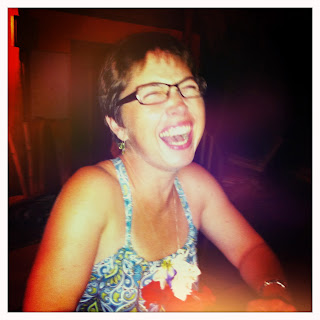Our second night on Ometepe, we decided to wander up the road to a hostel called Little Morgans, which was supposed to have a treehouse with a great view. Located about half a mile up the "road" (unpaved), a sign pointed us down another unpaved lane through a beautiful field of flowers and greenery. At the end we followed the sounds of Sting and the Fine Young Cannibals to find a roughly thatched, open-air bar which at first didn't appear to be run by anyone. Eventually we found the manager, who pointed us to the treehouse, and we climbed up to take in the view.
 |
| View from the top |
 |
| Little Morgan's "Treehouse" |
After climbing back down, we insinuated ourselves into the bar scene. We ordered the plate of the day (made, I think, by a young expat working for his board), and drank beer with some Australian backpackers, while Elliot played pool with a group of Nica guys. The walk back was a challenge, as we'd forgotten our headlamp, and there were no lights at all in the velvet darkness - but my iPhone cast enough light to guide us over the bumpy terrain and we made it safely home.
 |
Elliot and Linda compare photos
|
The next night we went in the opposite direction, to join Don and Linda for dinner in Playa Santo Domingo. We'd planned to return on the last bus of the evening - but it didn't show up, so once again we ended up walking home in the dark. (Later we found out that the power had gone out all over the island - leading both to the darkness and, likely, the bus delays.) Luckily, most of the road between Santo Domingo and Casa Istiam is paved.
The darkness was absolute: although we passed the occasional person, dog, and horse - and were passed by the occasional bike (without headlights or taillights) - we could see nothing but the dim cloudy sky above, the silhouettes of trees on either side of the faint ribbon of road before us, and on either side a fantastic sparkle of fireflies that seemed to stretch on to infinity. We could hear a cacophany of night sounds, too: frogs, toads, crickets, and other nocturnal creatures. It was truly magical.
Eventually the bus caught up with us, and we climbed aboard, riding the last 1/4 mile home to Casa Istiam. Riding in the bus' dim yellow light I felt a mixture of relief and sadness at leaving behind the mysterious darkness. The more familiar sounds of bus engine, human exchange and laughter were comforting; but I couldn't help but feel that the darkness and night sounds all around us were important, too - an essential connection to the eart which most of us in the developed world have completely lost touch with.




















































